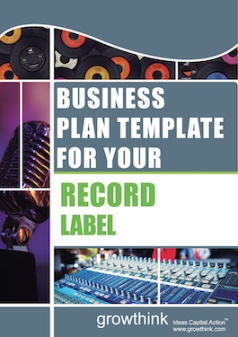Over the past 20+ years, we have helped over 1,000 entrepreneurs and business owners create business plans to start and grow their record labels. On this page, we will first give you some background information with regards to the importance of business planning. We will then go through a record label business plan template step-by-step so you can create your plan today.
What Is a Record Label Business Plan?
A business plan provides a snapshot of your record label as it stands today, and lays out your growth plan for the next five years. It explains your business goals and your strategy for reaching them. It also includes market research to support your plans.
Creating a business plan is one of the first and perhaps most important steps in starting a record label.
Why You Need a Business Plan for a Record Label
If you’re looking to start a record label or grow a successful record label, you need a business plan. A business plan will help you raise funding, if needed, and plan out the growth of your record label in order to improve your chances of success. Your business plan is a living document that should be updated annually as your company grows and changes.
Source of Funding for Record Labels
With regards to funding, the main sources of funding for a record label are bank loans and angel investors. With regards to bank loans, banks will want to review your business plan and gain confidence that you will be able to repay your loan and interest. To acquire this confidence, the loan officer will not only want to confirm that your financials are reasonable. But they will want to see a professional plan. Such a plan will give them the confidence that you can successfully and professionally operate a business.
The second most common form of funding for a record label is angel investors. Angel investors are wealthy individuals who will write you a check. They will either take equity in return for their funding, or, like a bank, they will give you a loan. Venture capitalists will not fund a record label.
Finish Your Business Plan Today!
If you’d like to quickly and easily complete your business plan, download Growthink’s Ultimate Record Label Business Plan Template and complete your plan and financial model in hours.
What Should a Record Label Business Plan include?
The record label business plan should include the following 10 sections:
1. Executive Summary
2. Company Analysis
3. Industry Analysis
4. Customer Analysis
5. Competitive Analysis
6. Marketing Plan
7. Operations Plan
8. Management Team
9. Financial Plan
10. Appendix
How to Write a Business Plan for a Successful Record Label
Below is a guide to help you create all 10 sections of your business plan:
1. Executive Summary
Your executive summary provides an introduction to your business plan, but it is normally the last section you write because it provides a summary of each key section of your plan.
The goal of your Executive Summary is to quickly engage the reader. Explain to them the type of record label you are operating and the status; for example, are you a startup or do you have a record label that you would like to grow.
Next, provide an overview of each of the subsequent sections of your plan. For example, give a brief overview of the music ndustry. Discuss the type of record label you are operating. Detail your direct competitors. Give an overview of your target customers. Provide a snapshot of your marketing plan. Identify the key members of your team. And offer an overview of your financial plan.
2. Company Analysis
In your company analysis, you will detail the type of record label you are operating.
There are three types of record labels. These are major labels, their subsidiaries (major label subsidiaries) and indie or independent labels. Major labels include Universal Music Group, Sony Music Entertainment, and Warner Music Group. These are regarded as the “big three”.
Each of these three major labels has several subsidiary companies under their banner. If you’re considering starting your own record label, then it would fall under the independent label.
In addition to explaining the type of record label you operate, the Company Analysis section of your business plan needs to provide background on the business.
Include answers to question such as:
- When and why did you start the business?
- What milestones have you achieved to date? Milestones could include sales goals you’ve reached, new store openings, etc.
- Your legal structure. Are you incorporated as an S-Corp? An LLC? A sole proprietorship? Explain your legal structure here.
3. Industry Analysis
In your industry analysis, you need to provide an overview of the record label.
While this may seem unnecessary, it serves multiple purposes.
First, researching the music industry educates you. It helps you understand the market in which you are operating.
Secondly, market research can improve your strategy particularly if your research identifies market trends. For example, if there was a trend towards decaffeinated record label consumption, it would be helpful to ensure your plan calls for plenty of decaffeinated options.
The third reason for market research is to prove to readers that you are an expert in the music industry. By conducting the research and presenting it in your plan, you achieve just that.
The following questions should be answered in the industry analysis section:
- How big is the music industry (in dollars)?
- Is the market declining or increasing?
- Who are the key competitors in the market?
- Who are the key suppliers in the market?
- What trends are affecting the music industry?
- What is the music industry’s growth forecast over the next 5 – 10 years?
- What is the relevant market size? That is, how big is the potential market for your record label. You can extrapolate such as figure by assessing the size of the market and then applying that figure to the music genre(s) you will be serving.
4. Customer Analysis
The customer analysis section must detail the customers you serve and/or expect to serve.
Record labels serve two types of customers: music artists and their fans.
In this section of your plan, start by detailing the music artists you represent or hope to represent.
With regards to the music artists’ fans, you should then detail the customer segments they include. Sample segments are college students, sports enthusiasts, soccer moms, techies, teens, baby boomers, etc.
If the artists you represent are in the same music genre, the fans of each should share similar demographic profiles.
Finish Your Record Label Business Plan in 1 Day!
Don’t you wish there was a faster, easier way to finish your business plan?
With Growthink’s Ultimate Record Label Business Plan Template you can finish your plan in just 8 hours or less!
Click here to finish your Record Label business plan today.
5. Competitive Analysis
Your competitive analysis should identify the direct competitors your business faces.
Direct competitors are other labels serving artists similar to the ones you want to serve. In your business plan, provide an overview of these competitors and document their strengths and weaknesses. Unless you once worked at your competitors’ businesses, it will be impossible to know everything about them. But you should be able to find out key things about them such as:
- What types of customers do they serve?
- What is their pricing (premium, low, etc.)?
- What are they good at?
- What are their weaknesses?
With regards to the last two questions, think about your answers from the customers’ perspective (the music artists). And don’t be afraid to ask your competitors’ artists what they like most and least about them.
The final part of your competitive analysis section is to document your areas of competitive advantage. For example:
- Will you provide superior record label services?
- Will you provide services that your competitors don’t offer?
- Will you provide better customer service?
- Will you offer better contract splits?
Think about ways you will outperform your competition and document them in this section of your plan.
6. Marketing Plan
Traditionally, a marketing plan includes the four P’s: Product, Price, Place, and Promotion. For a record label, your marketing plan should include the following:
Product: in the product section you should reiterate the type of music artists you serve/hope to serve and the services you offer.
Price: Document the general contract pricing (revenue and profit splits) you will offer clients.
Place: Place refers to the location of your record label. Document your location and mention how the location will impact your success. For example, is your record label located in an urban area with access to lots of musicians?
Promotions: the final part of your record label marketing plan is the promotions section, which details how you will get new clients and customers.
As a record label you need to market your company in order to get more clients, and you have to market your clients so they succeed and you both make money. Fortunately, when you do a great job marketing your clients, other artists hear of you and thus little additional marketing to them is needed.
As such, below are the most common and effective ways to market your record label’s clients:
- Collecting Email and Text Addresses: Developing an email and/or text list of music listeners who enjoy the bands your label represents may take time, but eventually offer a built-in base of potential buyers for each new album release or set a new tour date. It is important to make it easy to sign-up to the label’s email list at multiple points of contact – at concerts, via social media, and on the websites of the label and music artist.
- Building Release Schedules: It’s important to release songs in wanes. This helps to retain the audience’s interests. Whenever a new song is released, it will draw the most attention before tapering off. As interest begins to wane, release a new track. This keeps the momentum going and keeps people going.
- Concerts and Tours: The most immediate, direct way to get consumers to appreciate the music of your artists is for them to hear the artists live. This may become a bit of a “chicken and the egg” problem for you: concertgoers have to know of the artists, and have heard their music before, to want to attend their concerts, but concerts are a key way to market the artists. This is why newer artists are often sent out as opening acts for more established artists. As long as your label is skilled at successfully pairing your artists on concert tickets, you can benefit both groups of artists through this strategy.
- Public Relations: The release of a new album is newsworthy and, even if it does not seem newsworthy, it is the job of your company’s public relations director or firm to make it so. By encouraging new articles about the release and feature articles about the artists, PR people can create what amounts to free advertising in magazines and newspapers. Press releases must be tailored to the media outlet as much as possible, spoon-feeding them the “story” that should interest their readers.
- Offering Free Downloads: Releasing free tracks is an excellent way to attract interest because people are always in search of new songs. Consider placing these behind a download gate to ensure you get their email address and other contact information in return. If you prefer not to offer free songs, consider cover songs or demos.
- Creating Music Videos: Most fans search for songs on YouTube. Their video-sharing platform is an integral aspect of a record label’s marketing strategy. You may opt for an abstract video to a performance-based shoot. Lyric videos are also an excellent option.
- Hosting Contests: The relationship your label builds with the fans is a powerful step in building a brand. Each you include them in the project, you’re strengthening the relationship. Encourage fan involvement by inviting them to share ideas for t-shirt designs, videos, etc. Incentivize these tasks and offer prizes.
- Social Media Marketing: Conducting social media marketing will connect artists with existing and new fans. It not only builds brand loyalty and awareness, but can generate significant sales of concert tickets and merchandise.
- Partnerships: Partnering with other companies (such as sports companies, apparel companies, and consumer goods companies) that appeal to your artists’ fans could be mutually beneficial to you and your partners.
Finish Your Business Plan Today!
If you’d like to quickly and easily complete your business plan, download Growthink’s Ultimate Record Label Business Plan Template and complete your plan and financial model in hours.
7. Operations Plan
While the earlier sections of your business plan explained your goals, your operations plan describes how you will meet them. Your operations plan should have two distinct sections as follows.
Everyday short-term processes include all of the tasks involved in running your record label. These tasks include marketing, publicity, sales and distributions, promotions, production, and creative services among others.
Long-term goals are the milestones you hope to achieve. These could include the dates when you expect to serve your 10,000th customer, or when you hope to reach $X in sales. It could also be when you expect to hire your Xth employee or launch a new location.
8. Management Team
To demonstrate your record label’s ability to succeed as a business, a strong management team is essential. Highlight your key players’ backgrounds, emphasizing those skills and experiences that prove their ability to grow a company.
Ideally you and/or your team members have direct experience in the music production business. If so, highlight this experience and expertise. But also highlight any experience that you think will help your business succeed.
If your team is lacking, consider assembling an advisory board. An advisory board would include 2 to 8 individuals who would act like mentors to your business. They would help answer questions and provide strategic guidance. If needed, look for advisory board members with experience in the music industry, industry contacts, and/or successfully running retail and small businesses.
9. Financial Plan
Your financial plan should include your 5-year financial statement broken out both monthly or quarterly for the first year and then annually. Your financial statements include your income statement, balance sheet and cash flow statements.
Income Statement: an income statement is more commonly called a Profit and Loss statement or P&L. It shows your revenues and then subtracts your costs to show whether you turned a profit or not.
When an artist signs up with your record label, your company will receive a percentage of the royalties. In return, the artist will receive a myriad of services, professional connections, and specialized campaigns.
In developing your income statement to forecast these revenues and expenses, you need to devise assumptions. For example, will you serve 1 client per year or 20? And will per-client sales grow by 2% or 10% per year? As you can imagine, your choice of assumptions will greatly impact the financial forecasts for your business. As much as possible, conduct research to try to root your assumptions in reality.
Balance Sheets: While balance sheets include much information, to simplify them to the key items you need to know about, balance sheets show your assets and liabilities. For instance, if you spend $100,000 on building out your record label, that will not give you immediate profits. Rather it is an asset that will hopefully help you generate profits for years to come. Likewise, if a bank writes you a check for $100.000, you don’t need to pay it back immediately. Rather, that is a liability you will pay back over time.
Cash Flow Statement: Your cash flow statement will help determine how much money you need to start or grow your business, and make sure you never run out of money. What most entrepreneurs and business owners don’t realize is that you can turn a profit but run out of money and go bankrupt. For example, let’s say a company approached you with a $100,000 performance contract, that would cost you $50,000 to fulfill. Well, in most cases, you would have to pay that $50,000 now for supplies, equipment rentals, employee salaries, etc. But let’s say the company didn’t pay you for 180 days. During that 180 day period, you could run out of money.
In developing your Income Statement and Balance Sheets be sure to include several of the key costs needed in starting or growing a record label:
- Recording: Depending upon where the record will be produced, you can expect the recording costs to range from $0 to $15,000. If you’re an audio engineer or have partnered with a music producer, then they might have their own at-home studio.
- Manufacturing: Most labels release digital music, but if you’re opting for vinyl or CDs, the cost can range from $1.2 to $6 per unit.
- Networking and Entertaining: This includes items such as travel, tickets, drinks, recruitment, attending shows, etc.
- Graphic Design: Developing the label’s logo, product design, cover design, etc.
- Legal Services: This can range in price greatly.. There are artist contract templates online but it’s always best to seek professional guidance with the first contract.
- Promotion: This can cost thousands of dollars because you’re going to be working with booking agents, music promoters, publicists, etc. to increase the artist’s awareness. It also helps spur ticket sales and record sales.
- Office lease and office supplies expenses
- Administrative salary expenses
10. Appendix
Attach your full financial projections in the appendix of your plan along with any supporting documents that make your plan more compelling. For example, you might include any signed contracts you have.
Summary
Putting together a business plan for your record label is a worthwhile endeavor. If you follow the template above, by the time you are done, you will truly be an expert. You will really understand the music business, your competition and your customers. You will have developed a marketing plan and will really understand what it takes to launch and grow a successful record label.
Finish Your Record Label Business Plan in 1 Day!
Don’t you wish there was a faster, easier way to finish your Record Label business plan?
With Growthink’s Ultimate Record Label Business Plan Template you can finish your plan in just 8 hours or less!
Click here to finish your Record Label business plan today.
OR, Let Us Develop Your Plan For You
Since 1999, Growthink has developed business plans for thousands of companies who have gone on to achieve tremendous success.
Record Label Business Plan FAQs
What Is the Easiest Way to Complete My Record Label Business Plan?

Growthink's Ultimate Record Label Business Plan Template allows you to quickly and easily complete your Record Label Business Plan.
Where Can I Download a Record Label Business Plan PDF?
You can download our record label business plan PDF template here. This is a business plan template you can use in PDF format.


 Business Plan Template Download
Business Plan Template Download How to Write a Great Business Plan
How to Write a Great Business Plan 100 Free Sample Business Plans
100 Free Sample Business Plans Finding a Business Plan Consultant
Finding a Business Plan Consultant The Perfect Business Plan Outline for a Great Plan
The Perfect Business Plan Outline for a Great Plan Music Industry Business Plan Template
Music Industry Business Plan Template